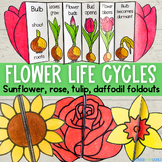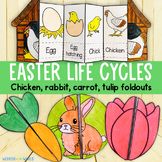Life cycle of a tulip plant foldable sequencing activity - cut and paste
Also included in
- Explore the life cycles of spring and summer flowers with these fun, foldable activities. This resource covers 4 life cycles (2 flowers that grow from bulbs and 2 from seeds): a sunflower, tulip, daffodil, and rose plant. For each one, there are multiple differentiated template options that allow yoPrice $5.99Original Price $10.00Save $4.01
- Link your life cycle unit to the Easter or spring season with these fun, foldable activities. This bundle contains differentiated templates for the life cycles of a rabbit, chicken, tulip flower, daffodil, and carrot. There's also a free bonus set of templates included for the life cycle of a sheep!Price $6.75Original Price $12.50Save $5.75
Description
Explore the stages of a tulip's life cycle with this fun foldable activity. Ideal as a spring science center, for an interactive science notebook, or to support learning about plants, life cycles, spring flowers, or seasonal changes.
Print the black and white templates onto letter-sized paper for students to color and cut out. There are 4 similar PDF cut-and-paste templates to choose from so you can pick one that best matches your students' needs.
Simple instructions with pictures are provided to help with folding. Once complete, the 2 halves of the tulip are brought together, then gently pulled apart to reveal the life cycle stages from bulb to flower inside.
US and UK versions are included. Please note this resource is not editable.
Benefits of this activity
- Low prep
- Children learn about the tulip life cycle in a fun and hands-on way, that’s a bit different from a standard science worksheet.
- Can be used to introduce the life cycle, or as a review/assessment to check understanding.
- Encourages fine motor/scissor skills, hand-eye coordination (folding), and sequencing.
- Differentiated options allow for multiple age ranges or abilities to do the same activity.
- Finished foldouts can be inserted into an interactive notebook where they can be referenced by children.
Also included:
- A set of sequencing cards with descriptions to use as an additional center.
- Some ideas for discussion
***Keep up to date with brand new resources by following my store***







